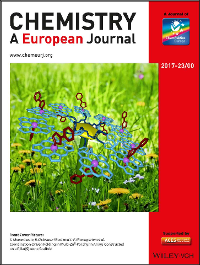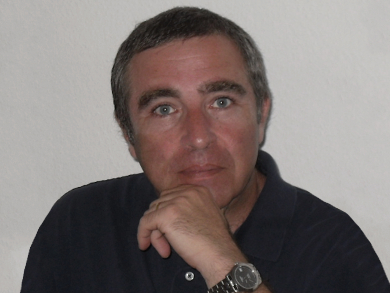Professor Jean-François Nierengarten talks to Vera Koester for ChemViews Magazine about his experiences with using short videos to summarize the main findings of a research study.
Jean-François Nierengarten is currently Directeur de Recherche at the Centre National de la Recherche Scientifique (CNRS) (DR1) and head of the Laboratoire de Chimie des Matériaux Moléculaires at the University of Strasbourg and CNRS in France. He created an animated cover for a recent issue of Chemistry – A European Journal. The movie shows the blooming of a molecular flower (a multi-ZnII-porphyrin array) upon the treatment with an imidazole ligand. Initially, he created the video to summarize the findings in his lecture.
What motivated you to create this animation and to send it to the editors? 
This particular paper describes the conformational changes in multi-Zn(II)porphyrin arrays that mimic the blooming of a flower. It was thus easy to propose a design for a cover page picture, but the artwork showing the molecular flower did not describe the dynamic of the folding/unfolding of the molecule described in the paper. I thus prepared a short movie and suggested to the editor that it could be used to prepare an animated cover page. The editorial team was very enthusiastic about the idea and the animation was then incorporated. I believe that this is a new way to summarize the main findings of a paper and I am very pleased that the journal liked the idea.
Do you often use short movies to summarize your work?
I started to post movies summarizing papers of our group on a YouTube channel last year. Progressively, I also introduced short animations in my lectures.
Where did you learn how to do this?
During my spare time, I enjoy drawing. To illustrate the chemistry of our group, I jumped into the world of computer generated imaging to create 3D artwork. I started to use Cheetah3D, an amazingly powerful 3D modeling software. Many examples of scientific illustrations I have prepared can be found on the web pages of our group.
Cheetah3D also includes an animation system to prepare short movies. Doing the small step from rendering artwork to the design of short scientific animations was thus a logical progression for me.
Is this just a “nice to have” or does it really add value to your work/publication?
I believe that all tools that may facilitate the dissemination of scientific information should be used. Video abstracts have been posted online by some journals, in particular by European Journal of Organic Chemistry. Without reading the paper you can get the essential information in a few minutes – this is great.
I encourage my students to watch these movies and often they then read the corresponding papers. In our modern society, information should be provided quickly. Short movies are perfectly suited for such a purpose.
The new generations of students are systematically using Google or YouTube to find information. They also follow news on Twitter and Facebook. It is thus important to be present on all those modern social media and to provide an easy access to scientific discoveries. I also believe that animated graphical abstracts should be introduced on the online versions of scientific journals to attract the attention of potential readers.
What is important when communicating your research visually besides technical skills to create the video?
When I was a student, the advice of Guy Ourisson [chemistry professor at the University of Strasbourg] for the preparation of lectures was “one slide, one idea – use a good picture rather than text”. At that time, we were using transparencies.
Now, with modern tools, one can easily introduce short movies in lectures to explain complicated molecular motions or physical properties. This is an efficient way to simplify the presentation of such phenomena and to capture the attention of the audience. Of course, it has to add something to your communication; one should avoid animations when they are not informative.
Did you receive feedback for your movies, so far?
Actually, people are asking me quite often what software I am using to prepare my artworks and animations. A couple of colleagues also asked me if I hired a professional designer for their preparation. This is rather flattering and suggests that the design of my pictures and movies is appreciated.
What is your research focused on?
My research activities have traditionally been centered on fullerene chemistry, but significant efforts have also been focused on dendrimers, luminescent transition metal complexes, macrocyclic compounds and π-conjugated systems. The various aspects of our research program are always highly synthesis-driven. The group has also successfully crossed interdisciplinary boundaries to pioneer new areas at the interfaces to biology and materials science, benefiting from strong international collaborative networks.
What got you interested in sciences? And what drives you today?
As far as I remember, I was always fascinated by natural sciences and wildlife. I started to study biology at the University of Strasbourg with the idea to become a zoologist. On the way, I discovered chemistry thanks to a couple of fantastic teachers. I definitively switched to chemistry after I met Jean-Pierre Sauvage during the first year of my Master. I had then the privilege to prepare my Ph.D. in the Sauvage team.
The enthusiasm of Jean-Pierre for science was contagious and I try to transmit the same virus to my students. Overall, one of the most rewarding parts of our job is to see former group members being successful in their independent career as faculty members in academia or as scientists in the industrial arena.
Anything else you would like readers of ChemViews Magazine to know?
This particular Chemistry – A European Journal paper with the animated cover is dedicated to Vincenzo Balzani for his 80th birthday. I have had the chance to meet Vincenzo 30 years ago when I was a Ph.D. student in the Sauvage group and still remember how I was impressed by the lecture he gave in our department. His ability to present complicated photophysical properties in a clear way for an audience of synthetic chemists was amazing.
During the course of my career, the concepts developed by Vincenzo and his group were always a source of inspiration for my own research. I had also several opportunities to meet Vincenzo and to discuss with him. He is not only a fantastic chemist but also a real gentleman. It is thus a real pleasure to dedicate him this paper on molecular flowers.
Thank you very much for the interview.
Jean-François Nierengarten studied biochemistry and chemistry at the University of Strasbourg, France, and received his Ph.D. under the supervision of Jean-Pierre Sauvage and Christiane Dietrich-Buchecker in Strasbourg in 1994. He worked as a postdoctoral fellow with François Diederich at the ETH Zürich, Switzerland from 1994–1996, and obtained a CNRS researcher position in 1996.
Jean-François Nierengarten is currently Directeur de Recherche at the CNRS (DR1) and head of the Laboratoire de Chimie des Matériaux Moléculaires at University of Strasbourg and CNRS.
Links to selected videos
Links to the group’s cover gallery
- The paper talked about:
Coordination-Driven Folding in Multi-ZnII-Porphyrin Arrays Constructed on a Pillar[5]arene Scaffold,
Thi Minh Nguyet Trinh, Iwona Nierengarten, Haifa Ben Aziza, Eric Meichsner, Michel Holler, Matthieu Chess, Rym Abidi, Christian Bijani, Yannick Coppel, Emmanuel Maisonhaute, Beatrice Delavaux-Nicot, Jean-François Nierengarten,
Chem. Eur. J. 2017.
https://doi.org/10.1002/chem.201701622
The animated cover is available from the Supporting Information
Selected Publications
- I. Nierengarten, S. Guerra, H. Ben Aziza, M. Holler, R. Abidi, J. Barberá, R. Deschenaux, J.-F. Nierengarten, Piling up pillar[5]arenes to self-assemble nanotubes, Chem. Eur. J. 2016, 22, 6185–6189. https://doi.org/10.1002/chem.201600688
- S. P. Vincent, K. Buffet, I. Nierengarten, A. Imberty, J.-F. Nierengarten, Biologically active heteroglycoclusters constructed on a pillar[5]arene-containing [2]rotaxane scaffold, Chem. Eur. J. 2016, 22, 88–92. https://doi.org/10.1002/chem.201504110
- L. Moreira, J. Calbo, B.M. Illescas, J. Arago, I. Nierengarten, B. Delavaux-Nicot, E. Orti, N. Martin, J.-F. Nierengarten, Metal-atom impact on the self-assembly of cup-and-ball metalloporphyrin-fullerene conjugates, Angew. Chem. Int. Ed. 2015, 54, 1255–1260. https://doi.org/10.1002/anie.201409487
- M. Mohankumar, F. Monti, M. Holler, F. Niess, B. Delavaux-Nicot, N. Armaroli, J.-P. Sauvage, J.-F. Nierengarten, Combining topological and steric constraints for the preparation of heteroleptic copper(I) complexes, Chem. Eur. J. 2014, 20, 12083–12090. https://doi.org/10.1002/chem.201402429
Selected Awards
- Grammaticakis-Neuman Prize from the French Academy of Science (2007)
- Catalan-Sabatier Prize from the Spanish Royal Society of Chemistry (2013)
The animated cover page of Chemistry – A European Journal




